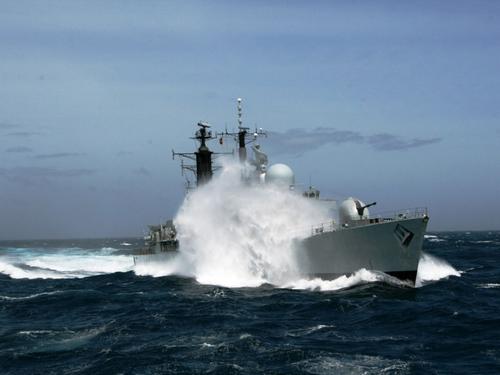
Welcome to MSW’s Scuttlebutt! Here’s the news for the day.

Feature - Making a Water Base, a lá Fulgoney
Going back to 2008, MSW Crew member Peter Fulgoney gives us a step-by-step on his technique in Making a Water Base.

The Air Defense Frigate Chevalier Paul Cleared for Active Duty
Source: French Navy
Admission to active duty is an essential step in the life of any ship. ‘Chevalier Paul’ will now be able to conduct operational missions and, in the coming days, she will take part in ‘Operation Harmattan,’ France’s share of the U.N. mission in Libya.
The frigate Chevalier Paul is the result of the Franco-Italian naval HORIZON program, which included the construction of two new-generation frigates for each country, and thus initiated the renewal of the two navies’ air defense components.
In French service, ‘Le Forbin’ and ‘Chevalier Paul’ replaced the missile frigates ‘Suffren,’ decommissioned in 2001, and Duquesne, decommissioned in 2007.
Chevalier Paul's mission is fleet air defense. Her principal anti-air weapons system allows her to cope with threats ranging from the latest missiles and to respond, notably thanks to its vertically-launched ASTER missiles, to large-scale air strikes. The ship’s electromagnetic discretion, and her ability to detect and decoy missiles, make her especially suitable for high-intensity operations as well as interventions in crisis areas.
The two Horizon-class ships can provide air cover for task forces (aircraft carrier, amphibious or civilian) against all aerial threats, including supersonic anti-ship missiles. They can exercise command and coordination of air operations from the sea, including those involving foreign aircraft. Their capabilities in other areas of naval combat also enable them to perform various other tasks, including securing a maritime area, control of maritime traffic, evacuation of nationals..., etc.
Russian Submarine Works with U.S. Sub Rescue System for First Time
Source: US Navy
AT SEA --- A historic international milestone was achieved when the Russian submarine, SSK Alrosa, mated with a U.S. submarine rescue system during exercise Bold Monarch 2011, June 7.
The coupling of the U.S. Submarine Rescue Diving and Recompression System (SRDRS) and the Russian submarine established an international interoperability and cooperation between the two nations.
"During Bold Monarch, 13 countries worked together to save submariners from the depths of the sea," said Capt. David Dittmer, deputy commander, Submarines North and tactical commander of all the units involved in the exercise.
Bold Monarch 2011 is a NATO exercise supported by both the Submarine Escape and Rescue Working Group (SMERWG) and the International Submarine Escape and Rescue Liaison Office (ISMERLO). Submarine escape and rescue is an international humanitarian aid effort that requires cooperation across national and alliance boundaries. ISMERLO was established in 2004 and is the international coordinating hub for global submarine rescue procedure, systems, equipment and support ships. It also ensures at least one of the world's rescue systems is available to be deployed immediately should an emergency occur.
The exercise took place off the coast of Spain, and featured submarines from Spain, Russia, Portugal and Turkey. Submarine rescue systems from the U.S., Russia, Italy and a jointly-owned NATO asset were proven compatible with every submarine.
"We enjoyed this chance to work together," said Capt. George Shelest, a Russian Federation Navy officer from the Russian Federation Navy Liaison Office. "It was a demonstration of good will from both sides, and a demonstration of the compatibility of our systems. I think that gives more of a chance to be saved if something goes wrong."
The coordinator of ISMERLO concurred with Shelest's assessment. "The cooperation shown between all the participants and observers of the exercise demonstrates the growing importance of international cooperation," said Bill Orr. "Now there is a greater chance of ensuring a successful rescue if a submarine casualty occurs."
The historical significance of the operation and exercise permeated the thoughts of all who participated, but resonated greatly with a U.S. Sailor assigned to the Deep Submergence Unit (DSU).
"Deep Submergence Unit is unique," said Machinist's Mate 2nd Class Joel Rivera, a forward attendant for SRDRS and whose DSU command is the U.S. Navy's sole provider of submarine rescue capability. "I never thought I'd be able to walk around on a Russian submarine; before I came to this unit, I didn't know these rescue capabilities existed. As a submariner, I will be more comfortable going back to submarines knowing all of these countries are willing to help if something goes wrong."
Rivera and U.S. Navy Sailor Joe Olin, a second class Navy Diver, presented Col. Zaycer Anton, commanding officer of the Alrosa, a plaque and an American flag to commemorate and honor the historical moment and cooperative effort between the Russian submarine and the U.S. rescue system.
More than 40 countries are known to operate more than 440 submarines world-wide, making the confirmation of rescue abilities between nations vital. These exercises foster safety and the ability to work together on a survival level, and also promote understanding and a commitment to stability through regional cooperation.

Battle of Saipan
Today is the anniversary of the Battle of Saipan.

USS Mars
Today’s website is USS Mars. Enjoy.
This Day in U.S. Naval History
1944 - Fifth Fleet lands Marines on Saipan, under the cover of naval gunfire, in conquest of Marianas.
1963 - Launching of combat store ship, Mars (AFS 1), first of new class of underway replenishment ships.
1991 - Two battle groups and amphibious ships evacuate dependents and Air Force personnel from Clark Air Force Base after Mount Pinatubo erupts in Philippines.
Diorama Idea of the Day

HMS Iron Duke navigating through heavy seas. To see the original high resolution photo, click here.
Gator











